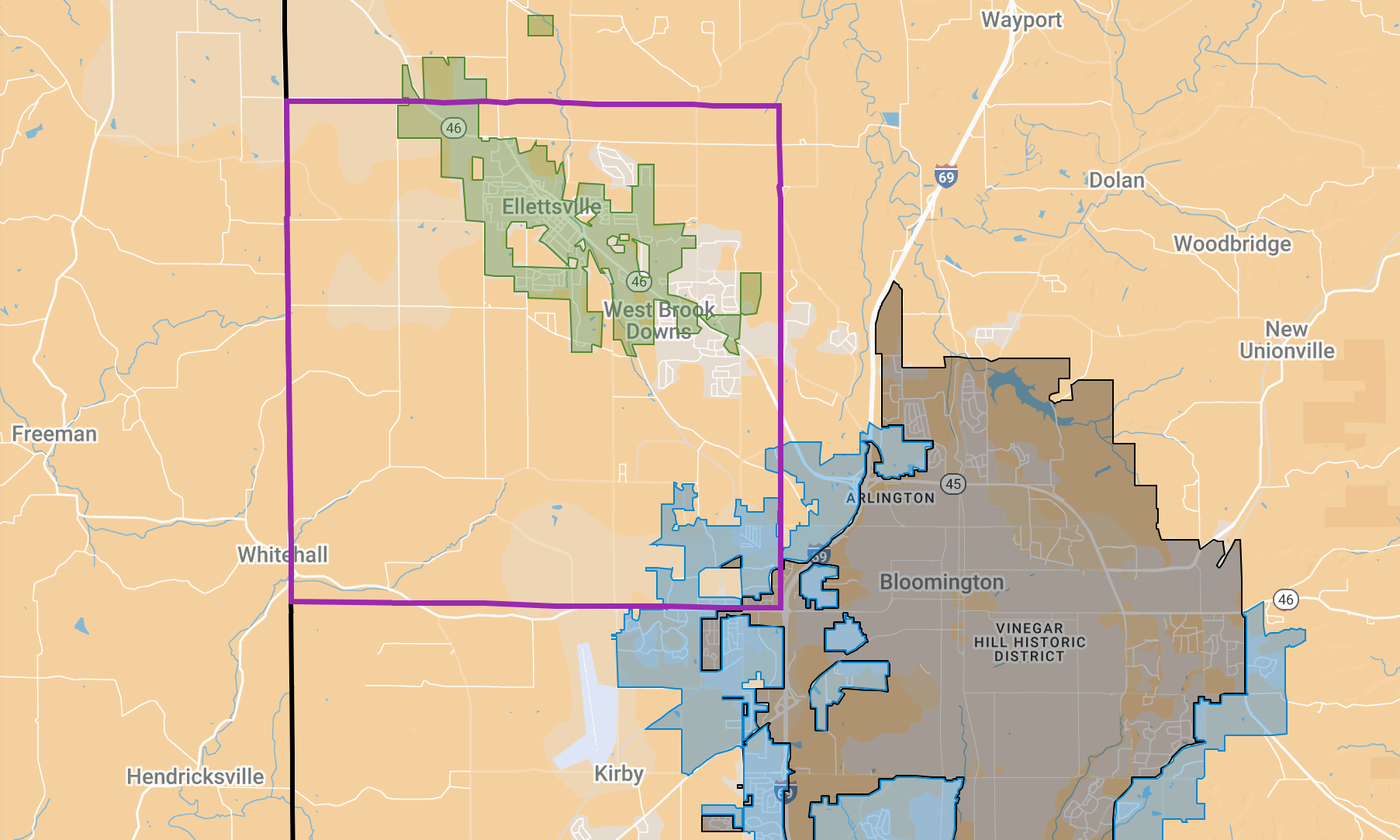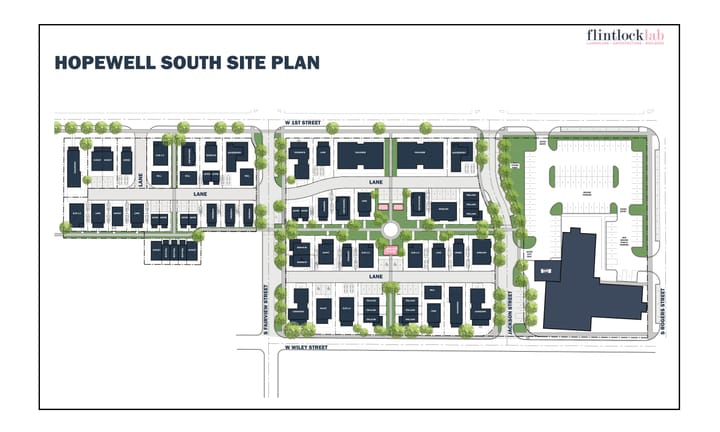Richland-Ellettsville consolidation proposal could feature rural–urban tax differences
At a joint meeting Friday, Ellettsville and Richland Township officials reviewed how a possible 2027 consolidation could structure taxes and services across rural and urban areas. Reorganization committee appointments will come soon.



Left: Map by The B Square with information from Bloomington and Monroe County governments. The green area reflects Town of Ellettsville boundaries as of 2020. The purpose square is Richland Township. Blue area is subject to pending litigation over Bloomington’s annexation attempts. Gray area with black boundary is city of Bloomington. [link to dynamic map] Right: Members of the Richland Township board and the Ellettsville town council meet to get a briefing on some illustrative budget numbers for a potential new consolidated governmental entity. (Dave Askins, Nov. 14, 2025)
In a move that could reshape local government in Monroe County starting as soon as Jan. 1, 2027, officials in Ellettsville and Richland Township are exploring a reorganization—a process that, if approved by voters, would blend the two governing entities into one.
The basic motivation behind the possible merger is described by government officials like this: “This proactive step would be a part of a collaborative effort to protect essential public services, preserve local identity, and create a more efficient and sustainable structure for future growth for the entire township.”
A joint meeting of the town and township boards on Friday afternoon helped clarify some of the key issues that could factor into a decision by voters—for or against consolidation.
Even though consolidation would yield one governmental entity with a single geographic footprint, a central concept emerged from Friday’s joint meeting: Not all property owners within the new entity would necessarily have to be taxed alike. How tax burdens would be distributed across the new entity could, at least in part, follow the current delineation between town and non-town parts of the township.
The distribution of the tax burden across the geographic territory would be incorporated into a fiscal plan that would be drafted by a reorganization committee, whose membership is not yet determined.
A key thread running through Friday’s discussion is the idea that the township is a geographic layer of government that includes the town. That is, Richland Township includes the Town of Ellettsville, except for a few town parcels that are included in Bean Blossom Township.
When population numbers are given for Ellettsville (roughly 6,700) and Richland Township (roughly 15,000), the figure for Richland Township factors in nearly all of Ellettsville’s population. The non-Ellettsville population in Richland Township is somewhat bigger than the Ellettsville population of the township, by about 2,000 people. Voters in Ellettsville help choose the members of the township board and the township trustee.
That has implications for the composition of the planned seven-member reorganization committee. Based on Friday’s discussion, it’s settled that the town council will choose three members, and the township board will choose three, with the seventh to be chosen by the initial six. What is not completely clear is whether the township board will necessarily confine itself to non-Ellettsville residents for its committee appointments, and whether the town council will necessarily confine itself to town residents for its appointments.
In any case, at Friday’s meeting, township and town officials alike indicated an interest in hearing from people who want to be appointed, encouraging potential committee members to contact the clerk’s offices of the town or the township.
Inside a newly consolidated town and township, state law allows for a geographic distinction to be maintained for purposes of setting tax rates and providing services. The difference between the tax rates and services provided would be spelled out in the reorganization plan. The reorganization plan has to be settled before the referendum.
Paige Sansone, with Baker Tilly Advisory Group, gave the joint meeting a breakdown of one hypothetical way for the tax burden and services to be distributed:
For illustrative purposes (from Baker-Tilly slide)
(rural)
(urban) (1)
(urban) (2)
Ellettsville Town (Reorganized)
The idea would be for the new consolidated entity to maintain a distinction between rural (for the non-Ellettsville part of Richland Township) and urban (for Ellettsville). Urban would be further divided into two categories—one for the part inside Richland Township and the other for the bit that is in Bean Blossom.
Sansone pointed out some of the similarities and differences. The basic rates would remain the same for county, library, and the solid waste district, because those tax rates will not be under the new entity’s control. The bit of Ellettsville that’s in Bean Blossom Township would continue to pay the same township rate to Bean Blossom.
But for other services like fire and police protection, there would be discretion. Sansone’s example, for illustrative purposes, would see fire protection service extended to all parts of the consolidated entity, with a uniform tax rate. That’s consistent with the fact that the town and the township already share a fire protection service.
But for police, Sansone said, the assumption was made that the distribution of taxes and provision of services would not be uniform across the new consolidated entity. That’s because the Monroe County sheriff would continue to provide services in the rural part of the new entity, in the same way the sheriff currently provinces police services to the part of Richland Township outside Ellettsville, Sansone said. On the other hand, for town administration, Sansone said, it would make “complete sense” that the cost would be spread out among all of the taxpayers, because the same level of service would be provided to them all.
During Friday’s joint meeting, Ellettsville Town council president Scott Oldham pushed back on the idea that the sheriff would necessarily provide policing in the rural part of the consolidated entity. Responding to Oldham, Sansone said the sheriff is technically already providing services within Ellettsville, adding that the sheriff should be asked about the question.
Sansone acknowledged that town and township officials should not just assume the sheriff would provide policing to the rural part of the consolidated entity, without a contractual payment. She pointed out that some town taxpayers make the argument that they get double-taxed for police protection—because they are paying for policing by the sheriff’s department in their county taxes, and for town policing in their town taxes.
Regardless of how the tax burden for services is sorted out in the reorganization plan, Sansone put together some figures for the sum total amount spent now by the town and the township governments ($7,976,727) and compared that to estimates for the amount the consolidated entity would spend ($9,301,000).
The estimates were based on what Sensone said she had been told was important to the community. Fire and police services got the largest increase in their budgets, at $1,324,273 total. That made up most of the difference in the totals of pre- and post-consolidation budgets. The one category that saw a decrease was administration, which dropped from $1,315,124 to $827,000 for a savings of about a half million dollars.
The bits of Richland Township that are already a part of the city of Bloomington would not be affected by any consolidation.
Ellettsville town council is looking towards a deadline of Nov. 21 for people to indicate their interest in serving on the reorganization committee. Richland Township board is looking for people to contact the township by Dec. 5, if they’re interested in serving on the reorganization committee.




Comments ()